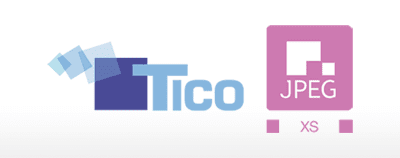
We thank all customers, partners and visitors for an amazing IBC Show 2018 and very much appreciate the great interest in our innovative video compression solutions. As every year, IBC was the ultimate stage for future trends in the broadcast industry. Out of everything that's going on, these are our highlights:
IP everywhere!
More than 50 vendors participated in the IP interoperability demonstration and educational sessions in this year’s IP showcase. Visitors saw and heard first-hand about the growing number of real-world IP deployments from broadcasters and media providers who are already adopting IP workflows. The interoperability setup made use of both, SMPTE ST 2110 and SMPTE ST 2022-7 standards, and AMWA NMOS specifications (IS-04, IS-05 and IS-06) in live production, contribution, and playout workflows.
The great business and creative potential of IP media solutions is undeniable. Especially thanks to the ST2110 and its upcoming part 22 for compressed video over IP, the full advantages of IP workflows can be released.
One codec for your whole IP workflow
Goodbye interoperability headaches. Thanks to its low complexity, ultra-low latency (microseconds), lossless quality and great compression efficiency, JPEG XS is the perfect codec to implement in your whole live production workflow across all stages, from capturing to editing. The upcoming lightweight codec is currently in its final stages of standardization at the ISO JPEG, with part 1 still expected to be released in 2018. At the same time, the SMPTE is defining additional parts of their ST 2110 standard for professional media over IP infrastructure, wit part 22 specifically defining the transport of compressed video over IP. As part of this rapid progress, a draft for the IETF RTP Payload Format for JPEG-XS (ISO/IEC 21122) has been submitted. With this first step taken, JPEG-XS is making its way to being standardized for Professional Media over IP as mezzanine compression for SMPTE 2110-22. This will once and for all open the gates for JPEG-XS' usage in Broadcast systems to transfer more pixels, at the best quality, with the lowest possible latency and complexity.
At this year’s IBC, intoPIX already showed a full hardware demonstration of the new TicoXS codec, completing the TICO product range with the upcoming ISO JPEG XS standardization, next to the already widely deployed TICO RDD35. As the intoPIX TICO algorithm has been selected by JPEG to create the novel standard, it eases future interoperability for all current TICO adopters. Any programmable chip (FPGA) or software built on TICO RDD35 can easily support TICO-XS.
Updated VSF TR-01 with ultra-low latency JPEG 2000
The addition of multiple amendments to VSF’s broadly used technical recommendation “TR-01” is a crucial step forward in the Broadcast industry’s IP transition. The update mainly focuses on:
1. Enabling end-to-end latencies of less than one frame, thanks to JPEG 2000 ULL
2. Supporting higher resolutions (UHD 4K), frame rates (120 fps) and bit depths (12 bit)
3. Expanding color space and adding mastering display metadata (as described in SMPTE ST 2086:2018)
intoPIX, with its EMMY® Award-winning JPEG 2000 IP-cores and their world-first Ultra Low Latency mode, are perfectly suited for end users that want to build their infrastructures based on the new TR-01. In a time where the industry moves from SDI to IP, innovative video compression technologies such as JPEG 2000 ULL display a sustainable alternative to and improvement over uncompressed data transport and is particularly suited for building competitive solutions in remote production, contribution and even studio infrastructures.
To view the VSF's full technical VSF TR01 recommendation for JPEG2000 Ultra Low Latency over SMPTE2022 1/2, visit videoservicesforum.org.
NHK's 8K Super Hi-Vision in the (near) future zone
This year's future zone again highlighted the Japanese national TV's efforts as a pioneer in 8K broadcasting. The future is very near however. Already by this December, their "Super Hi-Vision" TV channel will be broadcasting 8K content to the Japanese public. Over a year has passed since the official announcement of NHK's usage of the VICO-8 by Village Island. A system that makes use of the 4:1 compression ratio of the TICO RDD35 codec. This way, the bitrate of an uncompressed 8K stream is reduced from 48 Gb/s (60hz, 10 bit, 4:2:2) to 12 Gb/s, making it possible to squeeze a 8K signal down a single 12G-SDI cable, and retaining an unperceivable latency. During the last NAB Show, a similar system was shown to transport 8Kp60 over 10GbE IP networks with TICO.
But TICO is not only part of futuristic visions. Next to NHK showcasing their upcoming Super Hi-Vision 8K TV channel in the future zone, the TICO Alliance also presented an interoperability demo of multiple member's products - including a Village Island VICO-4 encoder and decoder. Many vendors have already adopted the innovative codec in their products. TICO RDD35 is available as IP-cores for FPGAs and runs efficiently on CPU & GPU software development kits, making it a versatile solution for a multitude of applications, including 8K.
With the 2020 Olympics located on the NHK's home turf, we are eagerly awaiting some 8K action.
You missed IBC 2018?
intoPIX will be at the SMPTE Annual Technical Conference and Exhibition in Los Angeles (CA), October 22-25 and interBEE in Makahuri fair ground (Japan), November 14-16.












